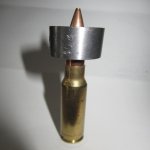Was loading some 223 with Hornady #2267 .224 55 gr FMJ-BT with cannelure bullets --
https://www.hornady.com/bullets/rifle/22-cal-224-55-gr-fmj-bt-with-cannelure#!/
-- and found that the COL was inconsistent round-to-round.
The brass is once fired Remington UMC sized in Lee Pacesetter dies and trimmed in a WFT. Overall case length is consistent and the brass is in good condition.
I dialed in the Lee bullet seater to give me 2.200" on the first round but then got 2.190" to 2.215" on all following rounds. Every round was inconsistent with not two consecutive rounds seating to the same depth. I eventually just set the die to seat high and then fine tuned each individual round with calipers and die adjustments to get 2.200" on each round.
I disassembled the die and made sure it was clean -- no problem there. I made sure that the shell holder and its mount in the RCBS RC IV were clean. Again, no problems there. I carefully watched and felt the depth adjuster on the Lee die to see if it might be moving and it does not seem to be. Have read that the Lee depth adjuster can be loose and can slowly screw itself in or out during use.
With all that eliminated, is inconsistent bullet shape and inconsistent ogive the most likely culprit here?
I use the Hornady #2267 bullets quite a bit and have never seen such inconsistent COL measurements from them. This was a new box that I bought maybe two months ago.
https://www.hornady.com/bullets/rifle/22-cal-224-55-gr-fmj-bt-with-cannelure#!/
-- and found that the COL was inconsistent round-to-round.
The brass is once fired Remington UMC sized in Lee Pacesetter dies and trimmed in a WFT. Overall case length is consistent and the brass is in good condition.
I dialed in the Lee bullet seater to give me 2.200" on the first round but then got 2.190" to 2.215" on all following rounds. Every round was inconsistent with not two consecutive rounds seating to the same depth. I eventually just set the die to seat high and then fine tuned each individual round with calipers and die adjustments to get 2.200" on each round.
I disassembled the die and made sure it was clean -- no problem there. I made sure that the shell holder and its mount in the RCBS RC IV were clean. Again, no problems there. I carefully watched and felt the depth adjuster on the Lee die to see if it might be moving and it does not seem to be. Have read that the Lee depth adjuster can be loose and can slowly screw itself in or out during use.
With all that eliminated, is inconsistent bullet shape and inconsistent ogive the most likely culprit here?
I use the Hornady #2267 bullets quite a bit and have never seen such inconsistent COL measurements from them. This was a new box that I bought maybe two months ago.















































































